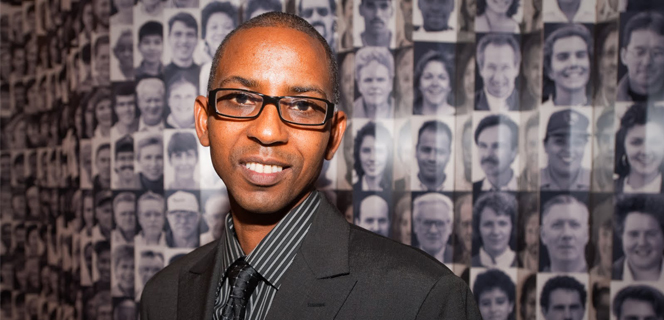| Discussion.
Skilled immigrants can play a role in helping with shortages in the workforce. Rebecca Tancredi of Upwardly Global for the Midwest said her organization’s mission is to eliminate employment barriers faced by skilled immigrants and refugees and to help them integrate into the U.S. workforce. “We’ve had great success in moving skilled immigrants from unemployment or low-skilled jobs into professional positions, often in the highest-demand sectors of our economy,” she said.
Minnesota has a great deal of opportunity because of its significant skilled- immigrant population. Upwardly Global has just started a pilot project of working with immigrants in the Twin Cities. Tancredi said the organization is currently exploring funding partners in the area. “We’re really interested in Minnesota and think we could play a strong role there,” she said.
The employment barriers skilled immigrants face are very solvable. A lot of the problem, Tancredi said, is immigrants’ lack of understanding of how to do a professional job search. Immigrants would send resumes with the wrong type of information or, if they had an interview, would do things in the interview that are culturally normal in their home country, but not in the U.S.
Tancredi said Upwardly Global does two things:
- It works on the job seekers’ side, helping them with their resumes, coaching them to talk about their achievements during an interview, to give a firm handshake, and to make direct eye contact.
- It also works with employers, who are very interested in the immigrant talent pool. But they often make mistakes, as well, Tancredi said. They may make the assumption that an immigrant needs sponsorship, which is expensive and time-consuming. But, in fact, all the immigrants Upwardly Global works with are already fully and permanently work authorized. Employers can become more sensitive to cultural issues and can learn to probe to get to the real issue-whether the immigrant has the skills to do the job.
This year, Upwardly Global will place about 640 immigrants in professional jobs and raise their family income by an average of $38,000 per placement. “It really changes the economic stability of the family,” Tancredi said. She pointed out that over 50 percent of Upwardly Global’s placements nationally are in positions employers report as the most difficult to fill. And Upwardly Global’s employer partners report increased diversity in their workforce and the ability to work in global markets as key advantages of hiring immigrants, she said.
Upwardly Global alumni maintain a retention rate of over 90 percent after one year of employment. She said the alumni tend to be very loyal to the business that helped them break the employment barrier. The retention rate also reflects the ability of immigrants to adapt to the American workforce, she said.
It’s estimated that the size of the talent pool of highly skilled, educated “new Americans” is more than 1.8 million. Tancredi said immigrants, refugees and asylees have arrived in the U.S. ready to work, but can’t find good jobs in their area of expertise. They are unemployed or underemployed in semi-skilled or unskilled job positions making poverty-level wages, she said. In Illinois, she said, the number is around 300,000.
Nationally, Upwardly Global has served 1,250 people this year and will serve 1,500 next year. “There’s a huge population and clearly, we’re not serving everyone,” she said.
In Minnesota, the trend is toward increasing numbers of immigrants. The percentage of foreign-born individuals in Minnesota, Tancredi said, rose from 7.2 percent in 2000 to 10 percent in 2012. Migration into the state will help sustain Minnesota’s population, she said, since its natural population growth will decline until 2050. According to Minnesota State Demographic Center projections, she said, the state needs an additional 83,100 net new in-migrants between 2016 and 2020 to maintain its present labor force growth of five percent.
Immigration helps offset the decline of younger age groups. New immigrants are disproportionately in their early working years, Tancredi said. The largest age category of new immigrants in 2012 was the 25-to-34 year-old group. “We see that in the people we work with at Upwardly Global,” she said. “Often they are young people trying to take advantage of winning a green card in the diversity lottery. That’s definitely true of the immigrants we have worked with in Minnesota.”
The Diversity Immigrant Visa Program (DV Program) makes up to 50,000 immigrant visas available annually. Visa winners are drawn in a random selection among all entries from countries with low rates of immigration to the United States. The DV Program is administered by the U.S. Department of State. Most lottery winners reside outside the U.S. and immigrate through consular processing and issuance of an immigrant visa.
The refugee population is another significant group in Minnesota. When employers think of refugees, they usually don’t think a refugee might be an engineer they could hire, Tancredi said. The U.S. policy with refugees, she said, is to try to make them independent as quickly as possible. This often results in them taking jobs below their skill level.
As immigrants make up a greater percentage of the workforce, she said, cities and states that capitalize on the pool of skilled immigrants will have an advantage economically. And that will help shift perceptions on immigration from a problem to a source of economic advantage, Tancredi said. “Shifting those perceptions can bring greater opportunities for smart immigration policy that is designed to help the U.S. address workforce issues strategically,” she said.
City and State workforce agencies should specify the ways they would like immigrants considered in their state plans, and recognize foreign-educated workers who are unemployed or underemployed as dislocated workers eligible for use of funding issued via the reauthorized Workforce Innovation and Opportunity Act (WIOA).
Employers say workforce-training programs are not producing workers with the skills they need. Tancredi said employers feel many training programs are not preparing people for the jobs most in demand or not preparing them adequately. “It could be that some employers have unrealistic expectations,” she said. An internship path is a great way to get past this barrier, she said, since hiring managers want to hire someone who hits the ground running. It’s not usually what they get, so employers must do some training on the job.
Internships can provide an opportunity for skilled immigrants to close any gaps between what they know and any new skills they might need on the job. Tancredi said her organization has an internship partnership with a group in Boise, Idaho. One of the main drivers for the Boise initiative, she said, was that the city and state were losing out on companies locating there because the population is not diverse. “They are intentionally trying to diversify their talent base to attract those companies,” she said.
The Boise group has funded 250 internships and Upwardly Global is one supplier of candidates for those internships, which Tancredi said are helpful to their clients. For example, a number of Upwardly Global clients might be great with technology and have computer science backgrounds, she said, but the technology they’ve been using in their home countries could be behind what’s used in the U.S. Internships provide the immigrants the learning experience to close any such gaps.
Policy can influence this workforce issue and help different states and employers access the talent pool of skilled immigrants. As an example, Tancredi pointed out that every state has a different approach to licensing engineers. Civil engineers must be licensed as professional engineers before to secure jobs at the level of previous positions. . People who graduate from a U.S. engineering school can take the initial fundamentals of engineering licensing test immediately after graduation which is step one in the process. In Michigan, engineering graduates from foreign schools can also take the licensing test immediately.
That’s not true in Illinois, she said. Engineering graduates must work for four years under a licensed engineer before they can take the licensing test. Because of this requirement, she said, Upwardly Global clients in Illinois will take the test in Michigan and, if they pass, put it on their resume. “Michigan is being very smart about this issue,” she said. “They are funding us to attract engineers and to get them to move to Michigan. And that is happening.”
While Upwardly Global’s ultimate goal for each client is a long-term job position, the organization sometimes uses short-term contract jobs to give clients U.S. work experience.
More than half of Upwardly Global’s immigrant clients have skills in job areas that are the hardest for U.S. employers to fill. Tancredi said the organization’s four largest placement areas are in engineering, technology, finance and accounting, and health care.
Part of Upwardly Global’s program is teaching immigrants about the American business style. “Workers from other parts of the world see Americans as very self promoting, very achievement oriented, very goal directed and very confident,” Tancredi said. “We value numbers and want to quantify things and value extraversion and assertiveness. These are cultural differences.” Because Upwardly Global clients from certain countries might be hesitant to speak up, she said, the organization teaches people how to be heard in a meeting, how to assert oneself and how to recognize social cues.
“While Upwardly Global is mostly about teaching job search skills,” she said, “we are completely available to immigrants after they’re placed in a job.” |








